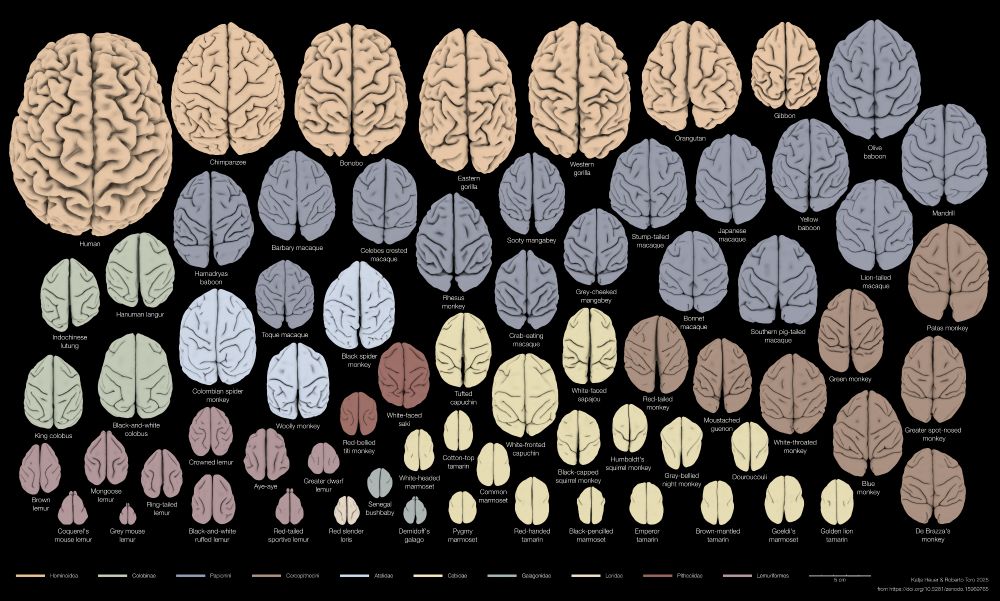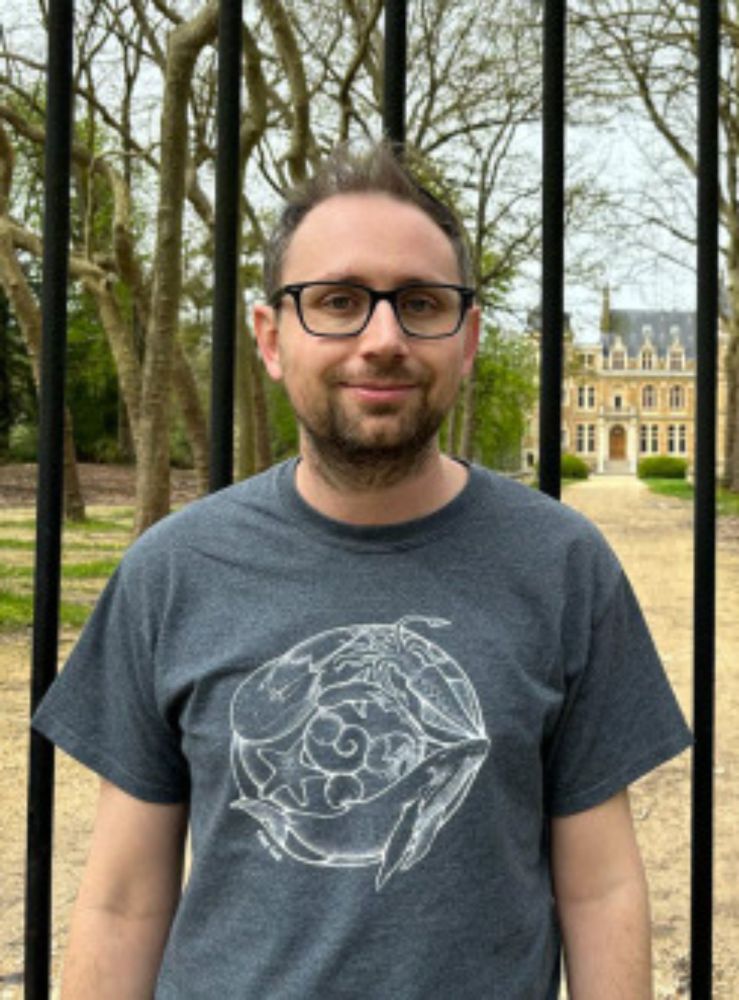Exciting new #Zebrafish research from the #WeinsteinLab, led by Jong Park!
“Specialized gas-exchange endothelium of the zebrafish gill” —
www.biorxiv.org/content/10.6...
Amazing to see red blood cells moving through the gills! Don’t forget to check out the supplemental movies ;-)
02.12.2025 22:48 — 👍 2230 🔁 328 💬 36 📌 20

The missing heritability question is now (mostly) answered
Not with a bang but with a whimper
I wrote a little bit about the "missing heritability" question and several recent studies that have brought it to a close. A short 🧵
21.11.2025 22:33 — 👍 351 🔁 170 💬 14 📌 21

Hi, I’m David Brückner @davidbrueckner.bsky.social.
I’ll take you through how cells in a tissue can use information distributed by biochemical gradients to make decisions, and how we can measure such positional information.
buff.ly/RFxVeHh
15.11.2025 08:00 — 👍 59 🔁 16 💬 1 📌 1

Sarah holds up an eel facts advent calendar in front of blooming flowers on her sidewalk. It says eel facts an advent calendar. It has 24 boxes with orange and yellow zigzags and yellow circles in the middle with numbers one through 24 in the middle of the boxes there are six eels depicted on this calendar, one green Moray, two splendid garden eels, one blue and yellow ribbon eel, and one American eel and one European.
This year we have sold 31% of the advent calendars that we sold last year 😓
The art is so pretty and colorful 🥺
The facts are so good 🥺
Eels are so cool 🥺
Get an eel facts advent calendar at EelFacts.net
09.11.2025 14:24 — 👍 274 🔁 209 💬 23 📌 34

"Spherical cows and bipedal goats: perspectives on mathematical models in biology". 13 and 14/11/2025 (Salle Jaurès, ENS-PSL, rue d'Ulm, Paris). More info about the event: montevil.org/talks/2025--...
01.11.2025 07:50 — 👍 35 🔁 14 💬 2 📌 0
I’ll be speaking about the mechanical development of crocodile and tortoise head scales next Wednesday at 4pm for the @tlmcambridge.bsky.social seminar series. Subscribe to the mailing list to hear more about my work, and that of @maltemederacke.bsky.social!
lists.cam.ac.uk/sympa/subscr...
30.10.2025 11:39 — 👍 33 🔁 10 💬 0 📌 0

This #RSOS paper studied the social development of infant rhesus #macaques throughout their first three years of life, and examined their peer relationships. Read more: royalsocietypublishing.org/doi/10.1098/...
26.10.2025 17:02 — 👍 4 🔁 4 💬 0 📌 0

The 2nd CogBases Workshop is this 4 & 5 Nov at Institut Pasteur!
We'll discuss the latest in open science methods for analysing brain imaging data. Registration free, but mandatory
neuroanatomy.github.io/cogbases-2025/
@k4tj4.bsky.social @cmaumet.bsky.social @bthirion.bsky.social @demw.bsky.social
14.10.2025 10:33 — 👍 12 🔁 9 💬 1 📌 1

Listen to live Moss Landing CA radio on Radio Garden
Listen to live Moss Landing CA radio on Radio Garden
Important alert for people who like working while a light white noise is playing in the background, there is a family of whales singing next to the Moss Landing Marine Lab hydrophone right now and you should listen! radio.garden/visit/moss-l...
09.10.2025 14:03 — 👍 202 🔁 68 💬 17 📌 20

We are getting ready for #ESHE2025 in Paris! 🎉
The #LHOSA #CoEvol #BrAIn team will share exciting new results on hominin evolution—talks & posters you do not want to miss.🧵👇 @palevoprim.bsky.social @cnrsecologie.bsky.social @univpoitiers.bsky.social
24.09.2025 15:05 — 👍 10 🔁 4 💬 1 📌 0

Brain Surfaces of 70 primate species
1
To predict the behaviour of a primate, would you rather base your guess on a closely related species or one with a similar brain shape? We looked at brains & behaviours of 70 species, you’ll be surprised!
🧵Thread on our new preprint with @r3rt0.bsky.social , doi.org/10.1101/2025...
27.07.2025 17:26 — 👍 498 🔁 225 💬 15 📌 26

Computational image analyst (m/f/d)
The Max Planck Institute for Molecular Biomedicine in Münster, Germany, has an opening for a
My lab @mpi-muenster.bsky.social is looking for a computational biologist with a passion for imaging and spatial biology. A staff scientist position with long-term perspective! Apply and spread the word 🙏 jobs.mpi-muenster.mpg.de/jobposting/0...
12.09.2025 06:17 — 👍 87 🔁 86 💬 1 📌 1
Complex behaviour is not limited to animals! Here we map the entire spectrum of waveforms dynamics on a quadriflagellate single cell with 4x 70um (!) #cilia, to a low dimensional behavioural manifold with surprising structure! #protistsonsky
All revealed in our new preprint doi.org/10.1101/2025...
23.08.2025 09:20 — 👍 88 🔁 28 💬 3 📌 2

Thibaut Brunet
Interview with Thibaut Brunet, who studies the evolutionary origin of animal morphogenesis
at the Institut Pasteur.
Check out our latest issue to read a Q&A with @thibautbrunet.bsky.social, who studies the evolutionary origin of animal morphogenesis at the Institut Pasteur. www.cell.com/current-biol...
14.05.2025 14:26 — 👍 34 🔁 10 💬 0 📌 1
Looking forward to speaking at the next TIBBE seminar!
04.09.2025 20:58 — 👍 6 🔁 1 💬 0 📌 0

🤩 Join us for the next TIBBE seminar:
Evolution of brain cell types.
September 10, 2–3pm UTC
This event brings together 2 outstanding evolutionary and developmental neuroscientists who will present their work, followed by an interactive discussion with the audience: www.crowdcast.io/c/evolution-...
04.09.2025 14:28 — 👍 18 🔁 17 💬 1 📌 6
The session will be hosted by the fantastic @neuroluci.bsky.social & @carmenfalcone.bsky.social We are so much looking forward to the talks &discussion
@ebablab.bsky.social @alealisousa.bsky.social @r3rt0.bsky.social @ornellabertrand.bsky.social @kkverkova.bsky.social @neuroecologylab.bsky.social
04.09.2025 14:46 — 👍 3 🔁 2 💬 0 📌 0
Excited for the upcoming TIBBE online talks &discussions with the amazing @matosches.bsky.social & @pkatz.bsky.social around
How can we define homologous cell types across vertebrates and invertebrates?
Next Wednesday, September 10, 2pm UTC, 4pm Paris 🧠🦎🐣🐭🌊 Join us www.crowdcast.io/c/evolution-...
04.09.2025 14:38 — 👍 19 🔁 7 💬 1 📌 0
The first of Jessie Foley’s work on the #evolution of #ageing in #Heliconius for your reading pleasure.
Come for the 348 day old butterfly, stay for the evolved slower rate of ageing, species*diet effects, and weightlifting for elderly butterflies 💪🏻👵🏻
🧪
03.09.2025 21:07 — 👍 42 🔁 10 💬 0 📌 2
Animals don’t just live in their environments—they transform them. And in doing so, they may also shape their own evolutionary trajectories. Our new paper in Trends in Ecology & Evolution introduces a framework for zoogeochemical niche construction. A thread 👇
21.08.2025 17:40 — 👍 64 🔁 28 💬 4 📌 3

Mixtopagurus paradoxus specimen photo by Laure Corbari, uncovered. It is a female with eggs. Its abdomen is outstretched but only slightly curved.
https://www.gbif.org/occurrence/1212549362

Xenophora robusta - A specialist in clam shells, each positioned concave side up (more or less).
http://www.zymoglyphic.org/exhibits/xenophora.html

Xenophora pallidula - An X. pallidula whose prizes are a nice pelican shell and a very long piece of coral
Mixtopagurus are nearly symmetrical hermit crabs. But they don't use worm tubes or wood like others in their family.
No, it's these weird Xenophora shells that stick stuff to themselves that have a whole exhibit:
www.zymoglyphic.org/exhibits/xen...
🦀🧪🦑 double? triple? #InverteFest
31.08.2025 11:41 — 👍 123 🔁 32 💬 8 📌 7
Buckling. Sounds ominous, doesn't it? Think bridges. But buckling can be a positive force and is common in nature. Marc Suñé's research may enable us to use it in many more applications.
Case study and full video: www.maths.ox.ac.uk/node/72526
28.08.2025 14:42 — 👍 14 🔁 3 💬 0 📌 0
This is such an interesting story about brain morphology and cognitive traits.
26.08.2025 22:19 — 👍 3 🔁 1 💬 0 📌 0

Please RP.
We are thrilled to announce that our lab’s first preprint is out!
”Whole-genome single-cell multimodal history tracing to reveal cell identity transition”
We report HisTrac-seq, a multiomic single-cell molecular recording platform.
www.biorxiv.org/content/10.1...
16.08.2025 07:15 — 👍 78 🔁 41 💬 2 📌 4
Thomas Deininger uses plastic waste to create sculptures,or should I say,works of Genius!!!!!!
23.08.2025 04:41 — 👍 7052 🔁 1929 💬 231 📌 217
It was great meeting @masahitotsuboi.bsky.social at #eseb2025 and learning about his fantastic research. Check his paper showing the interaction between micro and macro evolution! 🔥
24.08.2025 13:06 — 👍 12 🔁 3 💬 0 📌 0
One of the people I'm indebted the most for creating stunningly beautiful #mesoSPIM samples was Martina Schaettin - who tragically passed away in March this year. To honor her memory, Elkhan Yusifov created an award - submit your best #microscopy images & videos! www.linkedin.com/company/mart...
22.08.2025 17:32 — 👍 64 🔁 16 💬 2 📌 2

ecoevojobs.net 2025-26
The 2025-26 Eco-Evo job list is out. Good luck to those applying!
docs.google.com/spreadsheets...
19.08.2025 07:18 — 👍 207 🔁 215 💬 5 📌 3
Assistant Professor, McGill University | Associate Academic Member, Mila - Quebec AI Institute | Neuroscience and AI, learning and inference, dopamine and cognition
https://massetlab.org/
Computational Neuroscience doctoral candidate with Boris Gutkin / studying VTA GABA and Dopamine circuits and function
Research Engineer at Institut du Cerveau
Scientist studying biological tissues with neuronal circuits inside. Tweets my own.
Aquí, tuitejo el què em passa pel cap molt de tant en tant.
trickymons@X, cbosch@mastodon.world
SERI-funded #ERCStG Group Leader at PSI https://structuralneurobiology.ch, CV Starr Fellow at Princeton Neuroscience Institute, founder of https://ariadne.ai
Zebrafish, blood and lymphatic vessels, microscopes, imaging, aquaculture, cavefish, 3D printing, science. views my own.
ICREA Research Professor at Universitat de Barcelona. Research Group Leader at MPI-PKS and CSBD in Dresden. Theory of living matter. Collective phenomena in biology through the lens of active matter physics.
Research group leader at @mpipks.bsky.social and @mpi-cbg.de. Mechanics, mathematics, and more.
Account of the Max Planck Institute for the Physics of Complex Systems in Dresden; tweets by Pablo Pérez, Uta Gneisse, and Pierre Haas @lepuslapis.bsky.social.
The official account of Princeton University. In the Nation’s Service and the Service of Humanity.
Brains, Data and Science
Prof in Computational Neuroscience at Western University
Cerebellum and Motor Control
German-Brit rebel made in the 60s, RIBA architect & designer by trade. Tutor & writer by passion. Building dreams, breaking pencils. Living proof that realistic optimism is structurally sound 👍 Motto: 👉 #alwayslookup
#WomeninSTEM working @mecadev.bsky.social @mnhn.fr, exploring functional #morphology and #biomechanics of birds🐥🦖
Interested in #locomotion 🐧🦅🐤 #birdsong 🎶🐦, #feeding 🦆
Curator of the MNHN digital collection, in charge of @e-colplus.bsky.social
She/Her
User of microscopes. Interested in organelles and how they move. Husband, dad, intermediate filament apologist, and postdoc in the JLS lab at HHMI Janelia Research Campus.
art & architectural historian / visual, material & religious culture
Yawako W Kawaguchi/NIG Postdoc/BioInfomatics/Genomics/Green alga/Vertebrae
Japan
Assistant Professor @biozentrum.unibas.ch • Theoretical biophysics • Postdoc ISTAustria, PhD LMU Munich, MSc Cambridge University
www.biozentrum.unibas.ch/brueckner
A platform for life sciences. Publications, research protocols, news, events, jobs and more. Sign up at https://www.lifescience.net.
I am Full Professor at the Institute of Biology, Federal University of Bahia, Brazil, working on history, philosophy and science teaching; philosophy of biology; ethnobiology; and ecology and conservation.
Neuroscience & open science.
Lyon, France
























